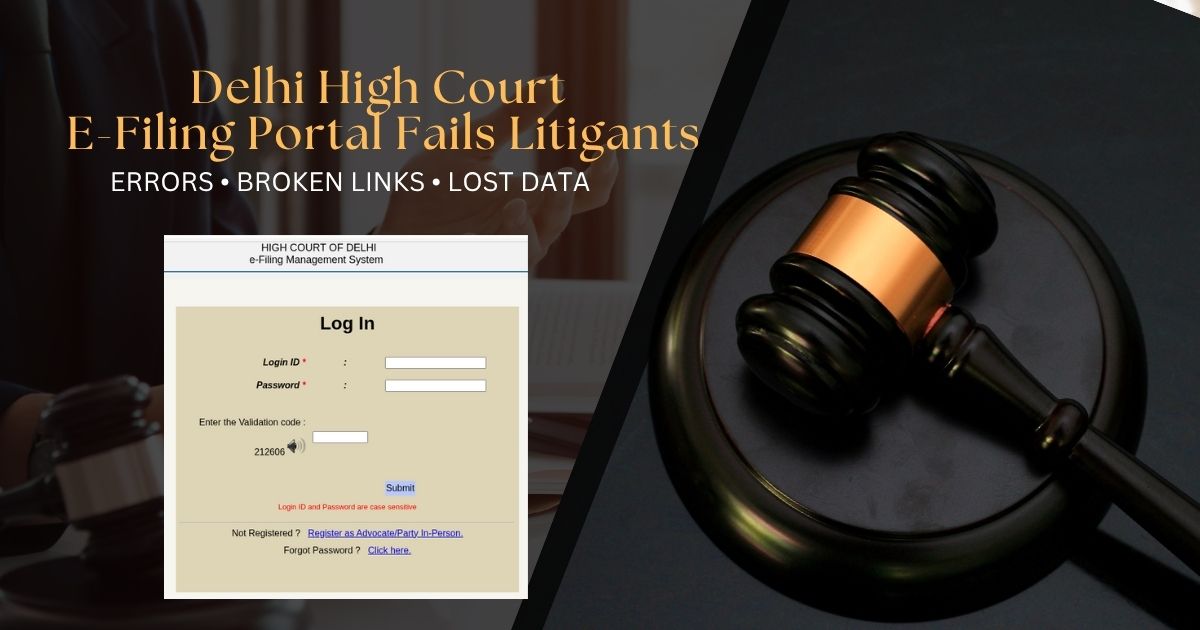Case Study — Failures of the Delhi High Court E-Filing Portal

Delhi High Court E-Filing Portal Fails Litigants. Errors • Broken Links • Lost Data. Photo: RMN News Service
Case Study — Failures of the Delhi High Court E-Filing Portal
The Delhi High Court’s failure reflects a deeper institutional issue: a culture resistant to technological transparency and lacking accountability.
By Rakesh Raman
New Delhi | October 12, 2025
New Delhi, India — A detailed analysis published in the India Judicial Research Report 2025 highlights that the Delhi High Court’s E-Filing Portal, intended to modernize India’s justice delivery, has instead become a glaring symbol of systemic dysfunction and the gap between digital ambition and judicial reality.
The report, a successor to the India Judicial Research Report 2024, was prepared by Rakesh Raman of RMN News Service and RMN Foundation. It concludes that technological initiatives such as e-filing across India remain underdeveloped, plagued by poor design, and lack adequate accountability mechanisms.
Digital Ambition vs. Ground Reality
The Delhi High Court’s E-Filing Portal was formally integrated in 2021 under the e-Courts Mission Mode Project, supervised by the Department of Justice and financed by the National Informatics Centre (NIC). Its stated objectives included reducing backlog, enabling round-the-clock online filing, allowing electronic fee payment, and promoting digital accountability and transparency. The vision aimed for a paperless, efficient judiciary.
However, the report documents that the portal’s implementation has been marred by frequent crashes, procedural opacity, and inaccessible interfaces. Specific, recurring problems cited by practitioners include:
- Non-functionality during critical filing windows, especially when approaching deadlines imposed by limitation periods.
- The system routinely rejects uploaded petitions using vague “technical error” messages without providing clear reasons.
- Broken document upload features fail to recognize standard archives or formats, such as PDF/A or ZIP archives.
- The absence of acknowledgment receipts leads to disputes over whether submissions were actually received.
- Rejections issued by the Registry are often arbitrary, lacking a digital trail to challenge or verify the decisions.
These persistent technical failures disproportionately impact independent lawyers, public interest litigants, and journalists who lack the institutional resources or familiarity with the registry that larger law firms possess.
[ 🔊 दिल्ली उच्च न्यायालय का दोषपूर्ण ई-फाइलिंग सिस्टम: ऑडियो विश्लेषण ]
[ 🔊 India Judicial Research Report 2025: Audio Analysis ]
Human Gatekeeping Behind a Digital Facade
The system was designed to reduce human discretion but has failed to do so. The process is characterized as a hybrid of digital inefficiency and human arbitrariness, ultimately defeating the goal of e-governance.
Behind the digital facade, the manual control of the registry persists, as every “e-filed” case still requires physical verification and approval by officials before it can be listed or numbered. This human gatekeeping keeps the process hierarchical, opaque, and prone to corruption. Lawyers report that registry staff often demand:
- Informal “follow-up” visits or phone calls to “expedite” processing.
- Repeated re-filings that serve no functional purpose other than to delay inconvenient petitions.
- Compliance with technical requirements that extend beyond the portal’s own stated rules.
Consequences: A Digitally Enabled Denial of Justice
The systemic dysfunction leads to tangible and severe consequences for access to justice. When filings are delayed or denied, limitation periods can expire, effectively killing cases before they are even heard. Public Interest Litigations (PILs) challenging state actions, such as those related to corruption or police matters, are routinely delayed under the pretext of “technical scrutiny”.
Furthermore, poor litigants who rely on online filing to avoid middlemen or travel are excluded because the portal’s design, interface, and language remain lawyer-centric and exclusively in English. The lack of a publicly accessible audit trail to verify why a filing was rejected or altered results in a severe loss of accountability.
The India Judicial Research Report 2025 contrasts this performance with other high courts, noting that the Kerala and Madras High Courts have implemented more robust e-filing systems with minimal registry intervention. The Delhi High Court’s failure reflects a deeper institutional issue: a culture resistant to technological transparency and lacking accountability.
The broader lesson drawn from the case study is stark: technology cannot cleanse a corrupt institution. Without administrative accountability and moral integrity, digital systems simply reproduce human corruption in code, turning “e-justice” into a bureaucratic maze.
Recommendations for Accountability and Global Access
To address these deep-seated problems, the report recommends institutionalizing digital accountability measures. These include creating mandatory public audit logs for rejected or delayed filings and implementing AI-assisted monitoring to flag systemic bias and anomalies in rejection patterns. The report emphasizes the urgency of technological and ethical reforms to prevent the erosion of the rule of law.
To ensure global scrutiny and academic traceability of its findings, the India Judicial Research Report 2025 has been archived on Zenodo, a global research repository developed under the European OpenAIRE program and operated by CERN. The report can be freely accessed, downloaded, and cited through its permanent Digital Object Identifier (DOI). This international archiving makes the findings accessible worldwide, providing a verifiable reference for global studies on judicial reform, corruption, and human rights in India.
By Rakesh Raman, who is a national award-winning journalist and social activist. He is the founder of a humanitarian organization RMN Foundation which is working in diverse areas to help the disadvantaged and distressed people in the society.
Rakesh Raman | LinkedIn | Facebook | Twitter (X)











